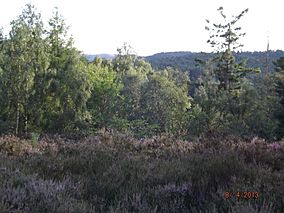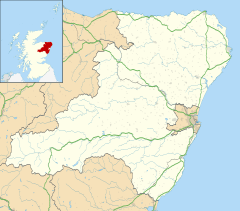Muir of Dinnet facts for kids
Quick facts for kids Muir of Dinnet National Nature Reserve |
|
|---|---|
|
IUCN Category II (National Park)
|
|
 |
|
| Location | Dinnet, Aberdeenshire, Scotland |
| Area | 11.7 km2 (4.5 sq mi) |
| Established | 1977 |
| Governing body | NatureScot |
| Muir of Dinnet National Nature Reserve | |
| Official name: Muir of Dinnet | |
| Designated: | 22 July 1999 |
| Reference #: | 1003 |
The Muir of Dinnet is a special place in Scotland, known as a National Nature Reserve (NNR). It's located near the village of Dinnet in Aberdeenshire. This reserve covers a huge area of 1166 hectares, stretching from the River Dee up to Culbean hill.
Muir of Dinnet is home to many different natural areas. You can find dry heath, wet bogs, thick woodlands, and two beautiful lochs: Loch Kinord and Loch Davan. It was first made a National Nature Reserve in 1977. This was because of its amazing plants and animals, and its unique landforms, like the famous Burn O'Vat.
The Dinnet Estate owns the land, and NatureScot helps manage it. They have a visitor centre, walking paths, and a car park for people to enjoy. About 40,000 people visit Muir of Dinnet every year to explore its natural beauty.
Contents
What Is the Geology of Muir of Dinnet?
The land at Muir of Dinnet has a fascinating history, shaped by ancient rocks and powerful ice. Most of the area sits on pink-coloured granite. This granite formed about 425 million years ago when melted rocks slowly cooled deep underground. This happened during the creation of a huge mountain range.
How Did Glaciers Shape the Landscape?
The landscape of Muir of Dinnet was greatly changed by glaciers. At times, thick sheets of ice, up to one kilometre deep, covered the area. When the last ice age ended, the climate warmed quickly. This caused huge amounts of meltwater to flow across the land.
This powerful water carried sand, gravel, and rocks, creating many unique features. You can see kettle hole lochs (lakes formed by melting ice blocks), kames (hills of sand and gravel), and eskers (long ridges of sand and gravel).
The Burn O'Vat: A Giant Pothole
One of the most amazing features is the Burn O'Vat. This is a deep gorge and a giant pothole. It was carved out by a powerful whirlpool of meltwater. This happened when the river met a very hard rock area, creating this incredible natural wonder.
What Wildlife Lives at Muir of Dinnet?
Muir of Dinnet is a fantastic place for wildlife because it has so many different habitats. Many types of plants and animals have been found here.
Trees and Plants of the Reserve
About 470 hectares of the reserve are covered in trees. On lower ground, you'll find lots of birch trees. Higher up the slopes, there are Scots pine forests. You can also spot rowan, willow, alder, and juniper trees.
There's a special area of aspen woodland, which is one of the biggest in Scotland. This woodland is home to rare plants like the aspen bristle moss and unusual fungi. Dry heathland, covered mostly in heather and bearberry, also supports unique plants and over 30 types of lichen. There are also two areas of raised bogs, which have plants like sedges and many kinds of sphagnum moss.
Birds of Muir of Dinnet
Over 140 different bird species have been seen at Muir of Dinnet. The lochs are very important for wildfowl that spend the winter here. These include whooper swans, goldeneye, wigeon, teal, mallard, and tufted duck.
Many of these birds, like mallards, teals, and tufted ducks, also stay to breed. Other birds, such as moorhen and sedge warbler, join them for nesting. In summer, migrant birds like redstart and willow warbler come to nest in the woods. On the open heaths, you might see curlew and skylark.
Mammals and Insects
You might even spot otters at Muir of Dinnet. Seven other important mammal species live here, including red squirrels and different types of bats like pipistrelle and brown long-eared bats. The reserve is also vital for insects, especially moths and water beetles. More than 349 species of moth have been recorded here!
What Is the History of Muir of Dinnet?
People have lived in the Muir of Dinnet area for a very long time, since the Mesolithic period. Many old remains have been found here.
Ancient Settlements and Battles
During the Iron Age, a crannog (an ancient lake dwelling) was built on Loch Kinord. People used this crannog until the 10th century. A logboat has even been found on the bottom of the loch. On the north shore of Loch Kinord, you can see a 9th-century Pictish stone.
The remains of a medieval home, surrounded by a moat, are on the north shore of Loch Davan. This building, called The Heugh, might have been where Andrew Moray stayed during the Battle of Culblean in 1335. Later, in the 17th century, the Burn O'Vat was a hiding place for a cattle thief named Gilderoy Macgregor.
Becoming a Nature Reserve
In the early 1800s, Loch Kinord was partly drained, lowering its water level. Later, in 1888, it was changed again to help provide electricity for Dinnet House.
The idea of making Muir of Dinnet a national nature reserve came up in 1949, but it didn't happen then. In the 1970s, it was first named a Site of Special Scientific Interest in 1971. Finally, in 1977, Muir of Dinnet officially became a National Nature Reserve. This was part of the celebrations for the Silver Jubilee of Queen Elizabeth.
Why Is Muir of Dinnet Protected?
Muir of Dinnet is protected in several ways because of its important natural features. Besides being a National Nature Reserve, it has other special titles.
Loch Kinord and Loch Davan are named a Special Protection Area (SPA) for birds. They are also a Ramsar site, which means they are important wetlands for wildlife around the world. Parts of the reserve are also included in two Special Areas of Conservation (SACs), which protect important habitats and species.
The reserve is part of the Muir of Dinnet Site of Special Scientific Interest. It also contains three scheduled monuments, which are important historical sites. The International Union for Conservation of Nature (IUCN) classifies Muir of Dinnet as a Category II protected area. This means it's managed mainly for ecosystem protection and recreation.
Images for kids




